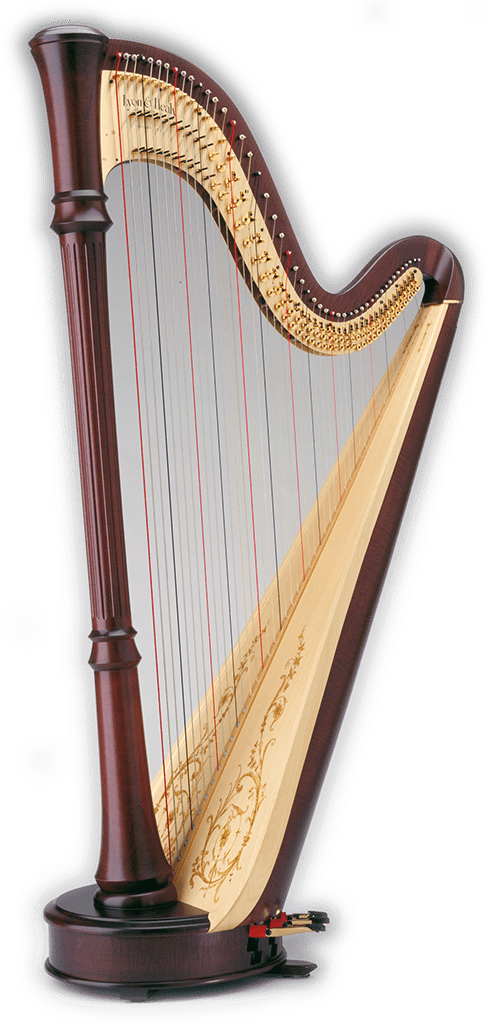Grandjany, Marcel, Trois Petites Pieces Opus 7 |
 |
 |
|
|
| Trois Petites Pieces Opus 7 |
| 4 Available |
Three intermediate pieces for pedal harp by Grandjany. Just a few pedal changes, these are marked. 7 pages. |
|
|
Three intermediate pieces for pedal harp by Grandjany. Just a few pedal changes, these are marked. 7 pages. |
|
|
Curcio, Stephanie, Trumpet Voluntary |
 |
 |
|
|
| Arrangement of Jeremiah Clarke piece for solo lever or pedal harp |
| 2 Available |
An arrangement of this staple piece of wedding repertoire for intermediate lever or pedal harp. This arrangement has a very full sound and is often used as a processional or recessional at weddings for its strong beat that is easy for any listener to pick up and walk to. This piece is often wrongly attributed to Henry Purcell, it is by Jeremiah Clarke. 2 pages. |
|
|
An arrangement of this staple piece of wedding repertoire for intermediate lever or pedal harp. This arrangement has a very full sound and is often used as a processional or recessional at weddings for its strong beat that is easy for any listener to pick up and walk to. This piece is often wrongly attributed to Henry Purcell, it is by Jeremiah Clarke. 2 pages. |
|
|
Pool, Ray, Tuning Your Lever Harp in E Flat Major |
 |
 |
|
|
| Guide to tuning a lever harp to three flats |
| 2 Available |
A lever harpist's comprehensive guide for tuning your lever harp in different keys. Organized in 3 sections: 1) How to use battery operated tuning meter, 2) Tuning the E flat major scale 3) Tuning by chord comparison . In compact pocket size: 5 1/4" x 8 1/2" 17 pages. |
|
|
A lever harpist's comprehensive guide for tuning your lever harp in different keys. Organized in 3 sections: 1) How to use battery operated tuning meter, 2) Tuning the E flat major scale 3) Tuning by chord comparison . In compact pocket size: 5 1/4" x 8 1/2" 17 pages. |
|
|
Owens, Dewey, Twelve Impressions on Pedal Patterns for Young Harpists |
 |
 |
|
|
| Twelve Impressions on Pedal Patterns for Young Harpists |
| 2 Available |
These pieces are described by Dewey Owens as intended "to give young harpists with limited technique and limited musical knowledge some pieces of musical interest within their capacity." This revised edition includes an excellent introduction by Dewey Owens. |
|
|
These pieces are described by Dewey Owens as intended "to give young harpists with limited technique and limited musical knowledge some pieces of musical interest within their capacity." This revised edition includes an excellent introduction by Dewey Owens. |
|
|
Liszt; arr. Dominique Piana, Two Ave Maria (Arcadelt/Liszt; Scheucker) |
 |
 |
|
|
| Two Ave Maria (Arcadelt/Liszt; Scheucker) |
| 2 Available |
Liszt's Two Ave Marias, one the famous tune attributed to Arcadelt, the other an original, were published as a set in an arrangement by harpist Peter Dubez, who worked in Liszt's court orchestra in Weimar. Liszt referred to them as "his Ave Maria for harp", which indicates that he must have supervised their transcription from the piano pieces. The Arcadelt is in a rather modern neo-classical style, while the second one is conceived in a late-romantic idiom. A third Ave Maria, subtitled The Bells of Rome, has been added as a bonus and was also transcribed in the 19th century, this time by Edmund Schuëcker. Each work is a substantial solo, and the third is downright virtuosic. |
|
|
Liszt's Two Ave Marias, one the famous tune attributed to Arcadelt, the other an original, were published as a set in an arrangement by harpist Peter Dubez, who worked in Liszt's court orchestra in Weimar. Liszt referred to them as "his Ave Maria for harp", which indicates that he must have supervised their transcription from the piano pieces. The Arcadelt is in a rather modern neo-classical style, while the second one is conceived in a late-romantic idiom. A third Ave Maria, subtitled The Bells of Rome, has been added as a bonus and was also transcribed in the 19th century, this time by Edmund Schuëcker. Each work is a substantial solo, and the third is downright virtuosic. |
|
|
|


